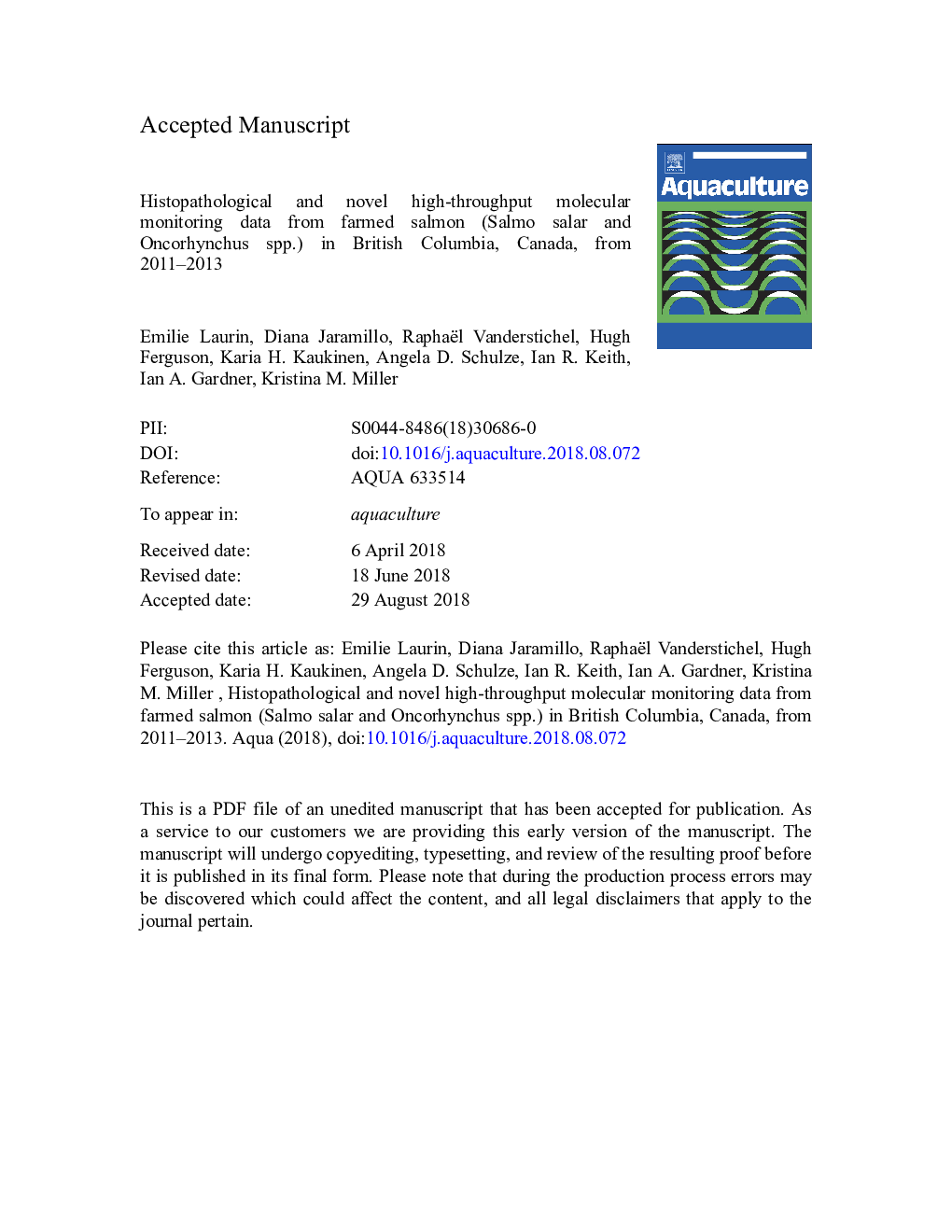| کد مقاله | کد نشریه | سال انتشار | مقاله انگلیسی | نسخه تمام متن |
|---|---|---|---|---|
| 10971197 | 1105219 | 2019 | 60 صفحه PDF | دانلود رایگان |
عنوان انگلیسی مقاله ISI
Histopathological and novel high-throughput molecular monitoring data from farmed salmon (Salmo salar and Oncorhynchus spp.) in British Columbia, Canada, from 2011-2013
دانلود مقاله + سفارش ترجمه
دانلود مقاله ISI انگلیسی
رایگان برای ایرانیان
کلمات کلیدی
موضوعات مرتبط
علوم زیستی و بیوفناوری
علوم کشاورزی و بیولوژیک
علوم آبزیان
پیش نمایش صفحه اول مقاله

چکیده انگلیسی
The purpose of the study was to describe spatial and time-at-sea patterns of endemic and new infectious agents and histopathologically-identified lesions in dead-and-dying farmed non-native Atlantic (AS) and native Pacific (PS) salmon in BC, between 2011 and 2013. Novel high-throughput molecular testing and blinded histopathological examination of tissues were used to evaluate these patterns in fish-level analyses. Twenty-five of 45 infectious agents were detected, and 87% of 897 total fish tested had mixed detections, with up to nine agents in a single fish, and a higher agent diversity in PS than AS. Most frequently detected agents were the parasite Desmozoon lepeophtherii (D.lep) in farmed AS (88%), and the bacterium Candidatus Branchiomonas cysticola (Ca.B.cys) in farmed PS (89%). Overall, 92% of AS and 88% of PS had some histopathological change, mostly of mild to moderate severity, with renal interstitial hyperplasia as the most frequent change (AS: 33%; PS: 48%). Spatial patterns were statistically significant for five agents in PS versus the same agents in AS for Fish Health Zones in southwest Vancouver Island, Sunshine Coast, and Discovery Islands. Statistically significant time-at-sea patterns were detected for three agents each in AS (piscine reovirus, Piscirickettsia salmonis, and D.lep) and PS (Ca.B.cys, Renibacterium salmoninarum, and D.lep). Importantly, infectious salmon anemia virus, salmonid herpesvirus, salmon alphavirus, and infectious pancreatic necrosis virus were not detected. Furthermore, while the agents associated with proliferative gill disease (D.lep, Ca.B.cys, and gill chlamydia) were all detected, few fish showed evidence of lesions associated with this multifactorial disease. The majority of agents detected on BC salmon farms were known to be endemic, but new findings include the marine detections of some infectious agents reported to only cause freshwater or hatchery-based diseases (Flavobacterium psychrophilum and Ichthyophthirius multifiliis). The results of this descriptive study provide the proportion of positive test results in sampled dead-and-dying farmed AS and PS, as well as spatial and time-at-sea information on both agent and lesion detection, targeting areas of interest and concern to researchers, regulators, and aquaculture industry veterinarians for future population-based analyses.
ناشر
Database: Elsevier - ScienceDirect (ساینس دایرکت)
Journal: Aquaculture - Volume 499, 15 January 2019, Pages 220-234
Journal: Aquaculture - Volume 499, 15 January 2019, Pages 220-234
نویسندگان
Emilie Laurin, Diana Jaramillo, Raphaël Vanderstichel, Hugh Ferguson, Karia H. Kaukinen, Angela D. Schulze, Ian R. Keith, Ian A. Gardner, Kristina M. Miller,